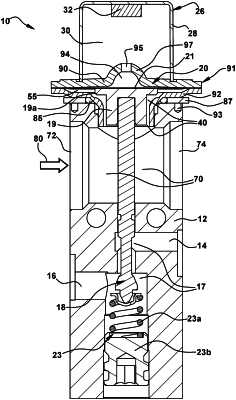| CPC F25B 41/335 (2021.01) [F25B 2500/15 (2013.01)] | 20 Claims |

|
1. A bulbless thermal expansion valve for a system, the expansion valve comprising:
a valve body having a first fluid passage extending between a first inlet and a first outlet of the valve body, and a second fluid passage extending between a second inlet and a second outlet of the valve body;
a valve member movable along a longitudinal axis relative to the valve body for controlling expansion of coolant flowing through the first fluid passage of the valve body;
a power element including a casing and a diaphragm coupled to the casing, the casing including a lower casing portion underlying the diaphragm and an upper casing portion overlying the diaphragm, the diaphragm having a first side operatively coupled to the valve member and a second side opposite the first side, wherein the second side of the diaphragm and the upper casing portion together form at least part of a sensing chamber that constitutes a thermal sensor of the expansion valve; and
a thermally insulative spacer arrangement positioned between the lower casing portion and the valve body at a position that is radially outward of the longitudinal axis;
wherein the thermally insulative spacer arrangement has a radially inner portion, and the thermally insulative spacer arrangement is configured to prevent direct contact of the lower casing portion with the valve body at all respective points of the lower casing portion and the valve body that are located radially outwardly relative to the radially inner portion;
wherein the expansion valve is devoid of a remote sensing bulb; and
wherein the sensing chamber contains a thermal sensing fluid in fluid communication with the second side of the diaphragm, such that changes in the temperature of the sensing fluid results in changes in pressure applied to the second side of the diaphragm, thereby causing movement of the diaphragm which provides movement of the valve member operatively coupled to the first side of the diaphragm.
|
|
16. A bulbless thermal expansion valve for a system, the expansion valve comprising:
a valve body having a first fluid passage extending between a first inlet and a first outlet of the valve body, and a second fluid passage extending between a second inlet and a second outlet of the valve body;
a valve member movable relative to the valve body for controlling expansion of coolant flowing through the first fluid passage of the valve body;
a power element including a casing and a diaphragm coupled to the casing, the casing including a lower casing portion underlying the diaphragm and an upper casing portion overlying the diaphragm, the diaphragm having a first side operatively coupled to the valve member and a second side opposite the first side, wherein the second side of the diaphragm and the upper casing portion together form at least part of a sensing chamber that constitutes a thermal sensor of the expansion valve;
wherein the lower casing portion is mounted to the valve body, and at least a portion of the lower casing portion together with at least a portion of the first side of the diaphragm form at least a portion of a fluid chamber that is fluidly connected to the second fluid passage of the valve body;
wherein a seal sealingly engages against the lower casing portion to fluidly seal the fluid chamber;
wherein a thermally insulative spacer or a thermally insulative coating is discrete with respect to the seal, and is arranged between the lower casing portion and an upper surface of the valve body to reduce heat transfer between the valve body and the casing;
wherein the expansion valve is devoid of a remote sensing bulb; and
wherein the sensing chamber contains a thermal sensing fluid in fluid communication with the second side of the diaphragm, such that changes in the temperature of the sensing fluid results in changes in pressure applied to the second side of the diaphragm, thereby causing movement of the diaphragm which provides movement of the valve member operatively coupled to the first side of the diaphragm.
|
|
19. A bulbless thermal expansion valve for a system, the expansion valve comprising:
a valve body having a first fluid passage extending between a first inlet and a first outlet of the valve body, and a second fluid passage extending between a second inlet and a second outlet of the valve body;
a valve member movable relative to the valve body for controlling expansion of coolant flowing through the first fluid passage of the valve body;
a power element including a casing and a diaphragm coupled to the casing, the casing including a lower casing portion underlying the diaphragm and an upper casing portion overlying the diaphragm, the diaphragm having a first side operatively coupled to the valve member and a second side opposite the first side, wherein the second side of the diaphragm and the upper casing portion together form at least part of a sensing chamber that constitutes a thermal sensor of the expansion valve; and
a ballast mounted in the sensing enclosure in spaced apart relation relative to the second side of the diaphragm;
wherein the expansion valve is devoid of a remote sensing bulb; and
wherein the sensing chamber contains a thermal sensing fluid in fluid communication with the second side of the diaphragm, such that changes in the temperature of the sensing fluid results in changes in pressure applied to the second side of the diaphragm, thereby causing movement of the diaphragm which provides movement of the valve member operatively coupled to the first side of the diaphragm.
|